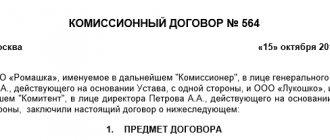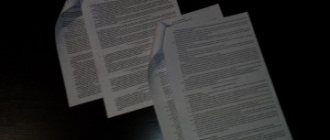In what cases are TORG-15 and TORG-16 compiled?
All movements of goods and material assets are taken into account by the accounting department on the basis of primary accounting documents. In case of damage to the goods or complete unusability, acts are drawn up approved by the Resolution of the State Statistics Committee of the Russian Federation dated December 25, 1998 No. 132 “On approval of unified forms of primary accounting documentation for recording trade operations”:
- Act on damage, damage, scrap of inventory items (TORG-15).
- Act on write-off of goods (TORG-16).
Since January 2013, filling out these forms is optional; however, the tax office may require documentary evidence of a decrease in tax expenses based on the write-off of inventory items or their markdown. Then correctly drawn up papers will be proof of the legality of these expenses.
The act in the form TORG-15 involves further actions with material assets , such as:
- Sale of goods without changing the price.
- Sale of goods at a reduced price.
- Disposal of goods.
- Complete destruction.
- Disposal to landfill.
Reference. The act in form TORG-16 excludes further use of the goods and is drawn up to remove the goods from the organization’s balance sheet. An act of write-off can be drawn up simultaneously with an act of damage, damage, or scrap of goods.
The specified documents are drawn up in cases of detection of commodity losses:
- Normalized, which appeared as a result of inevitable technological and physical processes (melting, drying, grinding, etc.).
- Non-standardized (damage, destruction, breakdown, incorrect storage technology, losses due to fire, accident, etc.).
How to fill out the TORG-15 form correctly
Losses from combat, scrap or damage to goods are written off to the account of the guilty employee. Damaged goods are destroyed. If it is not possible to identify the person responsible for the damage to the goods, then such losses are written off as non-operating expenses of the organization.
— reason for markdown or write-off of goods: damage, damage or scrap;
— code for the reason for write-off or markdown (if the organization does not use a code system, then put a dash);
- the reason for the formation of damage, breakage or scrap (for example, the goods were broken due to non-compliance with the rules for unloading goods);
- code for the reason for the formation of damage, damage or scrap (if the organization does not use a code system, then put a dash);
— names of damaged goods indicating the cost of the goods after markdown;
- position and full name of the employees responsible for damage to the goods;
— an order from the manager indicating further actions with the goods (discount or write off), the amount of losses from damage to the goods, as well as to the account of which employee to write off these losses.
*The product accounting system in the Class365 store will help you simplify your work with documents.
Registration of an act of damage, damage, scrap of inventory items
Filled out by whom?
To carry out an inventory and draw up a report on damage, scrap, and damage to goods, the head of the organization issues an order to create a special commission (at least three people), which includes a representative of the administration and a financially responsible person. The document is filled out by one of the commission members in triplicate.
Content
To draw up a document, you can take a unified form in the TORG-15 form or develop your own template based on it. Practice shows that a unified form is easy to fill out and understandable to representatives of regulatory authorities, so it is better to use the approved TORG-15 form. Let's look at the order of filling it out:
- At the top of the document the full name of the organization is indicated, indicating the legal address, telephone number and structural unit in which the inventory is carried out.
- Below is information about the full name of the supplier, indicating its full details, including bank details (current account, BIC, checkpoint).
- In special columns the document number and the date of its preparation are indicated.
- Title of the document: “Act on damage, scrap, destruction of inventory items.”
- A table consisting of fifteen columns is filled in:
- The name and characteristics are written down. For example, “Gingerbread “Mint”.
- Product code.
- Unit of measurement, name. For example, "pieces."
- Unit of measurement, code OKEY (all-Russian measurement code).
- Product article.
- Variety (category). For example, “1st grade”.
- Quantity (mass).
- The accounting price per unit of goods. For example, "75".
- Total amount for all goods. For example, "750".
- Then there is a section that includes four columns, which indicate:
- quantity (weight) of goods;
- new price (cost after markdown);
- total cost;
- markdown amount (the difference between the total amount for the product before and after the price reduction).
- The 14th column indicates the discount percentage.
- The last column indicates the characteristics of the defect. For example, “packaging violation”.
- The reason for the loss is indicated below the table. If the cause is technological processes or physical conditions, then in the line below, data on the perpetrators is not entered, otherwise the surname, first name, patronymic and position of the person responsible for the fight, scrap or damage to goods are indicated.
- On the back of the form, fill out the section entitled “Credit scrap (scrap).” It contains data about the product if it is impossible to further sell or use it.
Attention! When filling out, you must fully indicate the name of material assets, information about the supplier, the reasons and circumstances that led to damage to the goods.
Are mistakes acceptable?
The document must be drawn up without blots or errors. In case of corrections, it is better to reissue it. Calculations of markdowns or write-offs of goods must be made correctly, otherwise this will be the basis for the tax service to refuse to include expenses in taxable profit.
In case of errors in filling out and calculations, recovery of damages from the guilty party will be impossible.
Who signs?
The document is drawn up in triplicate and signed by all members of the commission and the financially responsible person. At the bottom of the act, under the calculations made, after checking the correctness of filling, the chief accountant signs. The papers are handed over to the manager, who, after making a decision, puts his signature on the front side of the act at the top of the form near the number and date of preparation.
Where is the TORG-15 act applied?
Damage to inventory items usually occurs as a result of careless handling of goods, improper storage and transportation. To write off unsuitable goods, a special commission is appointed consisting of the head of the company, financially responsible persons, and sometimes a sanitary inspection officer.
After clarifying the circumstances of the case, the commission members fill out the TORG-15 form in triplicate.
| ★ Best-selling book “Accounting from scratch” for dummies (understand how to do accounting in 72 hours) > 8,000 books purchased |
The document indicates the full composition of the commission, the name of the missing or damaged goods, its quantity, cost, causes of losses, defects that have arisen and the possibility of further use of goods and materials. The last point may imply several options:
- sale of goods at actual cost;
- sale of commodity or material assets at a reduced price;
- complete destruction of the goods;
- removal of goods and materials to a landfill;
- transfer to livestock feed and so on.
If there is a partial loss of consumer properties, the product is discounted. Then the act indicates two prices: this is the cost of the valuables before and after the markdown, and the amount of the markdown is also indicated.
If damage or loss of quality of valuables occurs, and the goods are not subject to subsequent sale, then an additional act TORG-16 is also drawn up in triplicate, which is signed by the head of the company and members of the created commission.
Registration of a write-off act
Filled out by whom?
If it is impossible to further use the goods, a write-off report is drawn up. The head of the enterprise issues an order defining the composition of the commission and its tasks. The act is filled out in printed form by one of the commission members and drawn up in triplicate (for the accounting department, for the structural unit, for the financially responsible person).
Content
You can use the unified form TORG-16:
- The first page states:
- name of the enterprise and its structural division;
- code according to OKPO, OKDP;
- basis for drawing up (number and date of order or instruction);
- number and date of filling out the document.
- The table is filled in:
- date of receipt of goods (from invoices - commodity TORG-12 or commodity transport 1-T);
- number of inventory write-offs;
- TN number and date;
- reasons for write-off and code (for example: intentional or unintentional damage, manufacturing or detected defects, violation of the integrity of packaging, expiration dates).
- On the back, fill in information about the product:
- name of the product, its code;
- unit of measurement of goods;
- OKEI unit code;
- quantity of goods;
- unit price;
- total cost.
Important! The document reflects complete information about the product and the reasons for its write-off.
Are mistakes acceptable?
The act is a primary accounting document, therefore corrections and errors in it are unacceptable. It is necessary to redo the document if it is drawn up incorrectly.
Who signs?
The document is signed by all members of the audit commission and the financially responsible person. Below, the manager writes a decision on how the goods will be written off:
- the guilty person indicating the last name, first name, patronymic and position;
- cost;
- profits, etc.
Together with what documents is the TORG-15 act drawn up?
When filling out a report on damage, scrap, or fighting, the following documents may be required:
- Order on the appointment of the composition of the commission - approved by the head and determines the members of the commission and their tasks (establish the degree of damage, write off unusable valuables and draw up the necessary documentation);
- Act on write-off of goods TORG-16 - allows you to formalize the procedure for deregistration, can be drawn up together with the TORG-15 form or instead of it;
- An invoice on the basis of which the disposal of recycled goods and materials will be carried out.
Act on damage to property due to flooding of an apartment or office
Flooding of apartments in multi-storey buildings is especially common. Offices can also be subject to this problem, as well as detached residential buildings. Even if there are no careless neighbors above the premises, flooding cannot be ruled out. There can always be a water supply failure, a breakthrough in the water heating system, a roof leak, etc.
One of the important procedural actions necessary for subsequent compensation for damage is drawing up an act of damage to property. It is compiled by representatives of the company servicing the building (its emergency service) called to the site of flooding with the participation of the injured party. This must be done within the first 12 hours after calling the authorized persons. If company representatives do not appear on time, it is permissible to draw up the act without them, inviting uninterested outsiders to the commission. In this case, the management company should be sent a written notice, and the act should indicate that it was informed, but did not participate in drawing up the act due to failure to appear when called.
If the room is flooded due to the fault of a specific person, for example, a neighbor above, he also participates in drawing up the act.
IMPORTANT! If the culprit was not identified, he could not be invited, or he refused, this should be reflected in the text of the act.
This document should reflect the following data:
- date and exact time of establishment of the fact of flooding;
- address of the location of the flooded premises;
- localization of water masses;
- the reason that water entered the apartment or office;
- the culprit of the flood (if identified);
- mention of witnesses (if there were any)
- description of water damage (based on visual inspection).
ATTENTION! When describing the damage, you need to indicate not only the condition of the ceiling, walls, floor, but also damage to furniture, papers and other property located in the room. This can be done in the form of a defect sheet, inventory, etc.
The remaining parts of the document (header, date, signatures of commission members) are drawn up according to the basic principles of office work. The laws do not provide for a strict form for the document.
ACT No. 11 of inspection of residential premises located at the address: Nizhny Novgorod, st. Vaneeva, 17, apt. 21 dated August 19, 2017
Based on the application (incoming number 134 dated 08/19/2017) from gr. Derevyansky N.Yu. regarding the flooding of the apartment, a commission was formed consisting of:
- Head of Housing Department No. 2 Morshansky A.P.;
- engineer of housing department No. 2 Peresvetova T.A.;
- foreman of housing department No. 2 Nikodimova O.L.
At the time of the inspection, the person responsible for the flooding could not be identified.
The commission conducted an inspection of the residential premises at the specified address.
At the time of the inspection (08/19/2017 at 16:30), the following damage due to flooding was established.
A living room with an area of 26 sq.m. was damaged:
- on a ceiling painted with water-based paint, water stains and stains are located over the entire surface;
- walls covered with non-woven wallpaper have streaks along the entire perimeter and are partially peeling off;
- the floor (laminate) has swelling at the joints;
- The door is wooden, painted, swollen and does not close.
The furniture wall in the room was damaged (swollen along the surface adjacent to the wall) and the Sony KDL-32WE613 TV (out of order).
The flooding occurred on August 19, 2017 at 15:45. The following rectification work was carried out:
- the hot water riser was closed at 16:00;
- hot water supply riser replaced (08/23/2017)
The commission's conclusions: the cause of the flooding is a failure of the hot water supply pipeline (pipe rupture).
Members of the commission: Head of Housing Department No. 2 /Morshansky/ A.P. Morshansky Housing Department Engineer No. 2 /Peresvetova/ T.A. Peresvetova Master of housing department No. 2 /Nikodimov/ O.L.Nikodimov
The act was reviewed by: owner of apartment No. 21 /Derevyansky/ N.Yu. Derevyansky
Why is the act needed?
The act is an important document of the organization. Based on this, damaged items are written off or sent for repair.
Depending on the extent of damage to property, disciplinary measures may be taken against the guilty employee:
- Rebuke.
- Comment.
- Dismissal.
- In some cases, even criminal liability.
When determining the penalty, all the circumstances of the incident will be taken into account, especially the presence of intent. In some cases, the employee may be required to pay damages.
Factors of cargo damage
Any cargo transportation is associated with certain risks.
They can arise despite the fact that the logistics company has extensive experience in the market. Possible factors leading to cargo damage include shaking, temperature changes, atmospheric phenomena and many other reasons. Due to such situations, the cargo may receive mechanical damage or lose its original properties. Of course, in this case the blame will fall entirely on the shipping company. However, the client himself must take care of the safe delivery of the transported goods.
The product must be well packaged. Durable packaging will reliably protect the cargo from external factors. After careful packaging, it is necessary to ensure that the goods are correctly placed and well secured. Modern manufacturers produce various kinds of durable packaging materials that will avoid any damage during transportation of goods. These types of packaging include: – corrugated cardboard boxes; – stretch film; - a film that consists of bubbles filled with air. The use of such packaging materials will avoid damage to the goods in transit.
When transporting goods by truck, the logistics company is obliged to ensure that the cargo is properly secured in the back of the vehicle. Despite all the measures taken, no company is insured against various incidents during transportation. Accidents, emergencies on the ship and other reasons can spoil the cargo.
Act on damage to property during delivery or transportation of goods
Even if delivery is carried out with all due care, damage to the goods transported cannot be ruled out. Without delving into the reasons and the search for the culprits, it should be noted that the cost of damaged or damaged cargo must be compensated - through insurance, the financial liability of the guilty party, or in another way. The damaged goods themselves must be included in losses when summing up the balance sheet. To do this, you need a documentary basis - an act of damage to property during cargo transportation.
If such problems are discovered upon receipt of the goods, the buyer (recipient), together with the person who delivered the goods (forwarder, courier, driver, company representative), must find out important details that will be mentioned in the act:
- name of the damaged product
- the amount of spoiled cargo in standard units of measurement (pieces, kg, meters, etc.);
- the nature of external damage to the packaging;
- whether the goods were properly packaged, whether there is the necessary marking on the packaging.
IMPORTANT! The act must be drawn up immediately after delivery, in the presence of the party who delivered it.
In addition to these details, the act should indicate:
- place of delivery and destination of the cargo;
- data about all parties: sender, carrier, recipient;
- delivery time (according to plan and actual);
- description of goods (in accordance with the documentation);
- what the cargo looked like upon arrival;
- approximate amount of damage.
The findings should establish the cause of the damage and the person responsible for it (if possible).
To ensure reliability, at least two more people must be invited as members of the commission. They can be qualified workers who can assess the damage and certify the damage, for example, an accountant of the recipient organization, a lawyer, a supply manager, etc.
It is advisable to attach additional documentary evidence: photos of the cargo, video recording from the carrier’s car, written evidence from eyewitnesses, etc.
You need to make at least 3 copies of the act:
- for the supplier of goods;
- for the person or company who carried out the transportation;
- for the recipient of the goods.
ACT No. 12 On damage to delivered cargo
Penza, August 17, 2017
The receiver of the goods, representative of Leto LLC Zarubin V.V., drew up this report on the damage to the delivered goods upon receipt.
- Sender of the goods: LLC "Our Lemonade".
- Recipient of the goods: Leto LLC.
- Transportation of goods was carried out by the carrier company Magistral LLC.
- Product description: 30 plastic boxes of Bell lemonade in glass bottles with a capacity of 0.33 l, 12 bottles per box.
- Value of the goods according to documents: 21,510 rubles.
- Consignment note No. 000045278 dated 08/17/2017
- Cargo departure point: Penza, st. Belyakova, 19, warehouse 1.
- Cargo destination: Penza, st. Austrian, 68, warehouse 2.
- Transportation time: estimated - from 12:00 to 14:00 (2 hours), in fact - from 12:30 to 13:45 (1 hour 15 minutes).
- Description of cargo received: upon delivery, 30 plastic boxes of lemonade were received, 12 bottles each, including 2 damaged boxes and 18 broken bottles.
- The packaging has not been opened, the seals are intact.
Applications:
- photographs of damaged boxes;
- photographs of broken bottles.
The established cause of cargo damage: excessive speed during delivery, which led to an accident - violation of transportation standards.
The recipient of the cargo, Leto LLC, is required to reimburse the amount of 2,000 rubles.
Members of the commission Head of the reception point of Leto LLC /Zarubin/ V.V. Zarubin Chief accountant of Leto LLC /Nezlobina/ E.P. Nezlobina Head of Warehouse No. 1 Leto LLC /Petukhov/ G.K. Petukhov
The driver of Magistral LLC /Rukavichkin/ R.A. has been familiarized with the act. Rukavichkin
Act on causing material damage (download sample)
This document does not have a general unified template approved at the legislative level, therefore it can be compiled in free form.
A sample act of damage to property usually has the following structure:
- date, time and place of drawing up the act;
- the composition of the commission that inspects the damaged property and draws up an act of damage;
- a list of damaged property, a detailed description of the nature and extent of damage;
- cause of damage (if possible to determine);
- an indication of the person through whose fault the described damage was caused to the property (if such a person has been identified);
- signatures with a transcript of all persons participating in the inspection of the damaged property.
Photographs of the damaged property can also be attached to such a report, which can later be used as evidence if the dispute has to be resolved in court.
It is not always possible to justify the amount to be compensated without the participation of a professional appraiser, therefore, perhaps, in addition to the damage report, a report on the assessment of such damage, drawn up by an expert, will also be drawn up.
It can also be difficult to determine the cause of damage (for example, the cause and exact location of the fire, etc.) - in this case, an expert opinion will again be required.
A sample property damage report can be downloaded from the link: Property Damage Report - sample.
How to draw up a cargo damage report in 2020?
The number of copies of the act depends on the number of interested parties. If there is a supplier, a carrier and a recipient, the document must have three copies. All existing damage must be described in as much detail as possible. At the same time, you should try to avoid exaggeration. Indeed, if the culprit does not agree with the specified information, he will be able to appeal this claim. You need to understand that if the matter comes to trial, this act will be an important argument.
At the discretion of the commission members, various additions may be attached to the act. For example, this could be photo and video materials. If there are eyewitnesses, you can take written statements from them. Information about such additions must be displayed in the act.
Contents of the act
The header must contain the name of the act and its number. The city and date of registration are also indicated here. After this comes the main part, which is as informative as possible:
- information about the sender;
- information about the receiving party;
- detailed information of the carrier company;
- details of audit team members;
- details about the cargo, its characteristics, point and date of departure and receipt, transportation time, other details;
- total cost of cargo;
- information about damage to both seals and packaging, and the cargo itself;
- if there are annexes to the act, which ones are indicated;
- the reasons why the cargo was damaged;
- the amount for which the recipient is making a claim.
Of course, the number of points can be increased. It all depends on the specific situation. The final part of the document is intended for signing autographs with transcripts. The act is signed by all responsible persons.
What is a document destruction act?
The act of document disposal is drawn up by the person physically carrying out the destruction procedure. The document contains complete destroyed titles. The legal acts in accordance with which a particular security was liquidated must be indicated.
The act of destruction of documents is approved and signed only after the procedure for the actual destruction of documentation is completed.
The procedure for liquidating securities can be carried out by an outsourcer. In this case, you need to carefully check the document to ensure compliance with all legal regulations. It is important that the document drawn up can actually serve as confirmation of the liquidation procedure.
You can find out how to draw up an inventory report and download its sample by following the link.
What should you check when drawing up an act?
- Provide a complete list of destroyed documentation;
- Indication of references to the legal acts in accordance with which the destruction was carried out;
- Certification of the document personally with the signature of the general director of the company.
What does the legislation say?
The main document accompanying the destruction procedure is the act of allocating documents for destruction. It is a list of various documents proposed for liquidation, indicating their number.
The form of the document destruction act is determined by the “Basic Rules for the Operation of Organizational Archives” (confirmed by the decision of the Board of the Federal Archival Agency of February 6, 2002).
You should also refer to the Resolution of the FCSM of the Russian Federation (Federal Commission for the Securities Market) dated July 16, 2003 No. 03-33/ps “On approval of the Regulations on the procedure and terms of storage of JSC documents.” The document defines the following:
- In order to guarantee the safety of documentation, acts are drawn up only after the formation of inventories of cases of indefinite or temporary storage. Inventories and acts are reviewed by the Expert Commission and approved by the management of the organization;
- Cases included in the ratified document destruction act must be separated from other papers. They are stored in a specially designated place;
- The act of allocating documents for destruction, as well as the inventory, is stored in the company’s archives in the file being formed.
The State Archive has established rules governing storage. Their list was approved on October 6, 2006. According to this legal act, documents are stored by:
- Short time - from one year to five years;
- For long periods (from 10 to 75 years);
- Some documents cannot be destroyed at all.
The type of archive does not matter: documents can be stored either in your own archive or in a company-owned archive.
The list states the following:
- Annual tax reporting is stored permanently, quarterly – for five years, monthly – for one year;
- Annual balance sheet and accounting statements are stored permanently, quarterly - for five years, monthly - for one year;
- “Primary” (primary accounting documentation) is stored for five years;
- Personnel documentation is stored for 75 years. This includes orders for the appointment and transfer of employees, personal files, report cards for hazardous industries, etc.
Thus, it is possible to identify key documents that are not subject to liquidation. Documents with an indefinite storage period include annual accounting and tax reporting, annual balance sheets. In the event of any audit or claims by the tax authorities, such documentation will confirm that the company has made all payments to the budget in full, and their amounts can be verified at any time.
A commission formed at the institution selects documents that need to be kept permanently. This list is compiled in ascending order (from the beginning of the year to its end). Four copies of this list are signed by the manager.
Documents with an indefinite storage period are sent to the state archive or placed in their own archive. Every year an order is drawn up indicating the person responsible for safety.
Certificate of destruction of documents - sample filling:
Sample act on the destruction of documents of Rassvet LLC.
Registration of the act. What to pay attention to
When drawing up an act, as well as when writing it, you can be guided by your own considerations, since the law does not impose any special requirements on this parameter. The act can be written on a simple blank sheet of paper or on the organization’s letterhead. You can enter information by hand (with any ballpoint pen, but not a pencil) or type it on a computer.
Important! The act must contain the signatures of its immediate compiler and the employees present - their autographs will indicate that all the information entered in the document is correct.
It is advisable to obtain the signature of the perpetrator of property damage, but if he refuses to sign the document, you can make a corresponding note directly in the act or draw up a separate act of refusal to sign the act.
It is not necessary to certify the form of the act with a seal - from 2020, the use of stamped products in enterprises and organizations is necessary only in cases where this is enshrined in the internal regulatory documents of the company.
The act is drawn up in two copies:
- one remains in the company and is sent to the accounting department to write off property or allocate money for repair work,
- the second is transferred to the employee who caused the damage.
If necessary, you can make additional copies of the act.
Form
It is worth recalling that starting from 2013, the use of most unified forms is not mandatory. Of course, no one forbids using the usual form. However, this is a purely personal opinion of each organization. In other words, the head of the company has the right to independently choose the method of registration. It is even allowed to draw up an act in free style on A4 paper. Although many companies develop and approve their own forms. They contain all the important columns that just need to be filled in with the relevant information.
How to record cargo damage
It can be said that the application of this act has no restrictions. The document can be drawn up in various areas. The most popular of them include:
- transportation of goods between structural divisions that belong to the same company;
- transportation of goods from one company to another, for example, a manufacturer delivers its products to a purchasing company;
- the need to send products with the help of specialized companies that provide forwarding services.
As a rule, an agreement is drawn up between the sender and the recipient. This may also be other regulatory documentation. Among other things, information about the exact method of transportation will be provided here. Thanks to this, possible risks are minimized. It is logical to assume that if the carrier violates the previously agreed transportation rules, this may lead to damage to the cargo. Particular attention is paid to fragile items that are easily broken. The carrier must adhere to certain recommendations.
If the recipient discovers that the cargo is damaged, he has the right to record this fact using a special act. To do this, specialists with the necessary qualifications carry out an inspection. Taking into account the characteristics of the damage, it is possible to determine at what stage of transportation the cargo received deformation. All details of this investigation are reflected in the report. Those in charge then reach a conclusion by making a claim. Usually the document specifies the amount of loss that must be compensated by the carrier.
( Video : “The carrier’s responsibility for the cargo. Presumption of guilt of the carrier.”)









